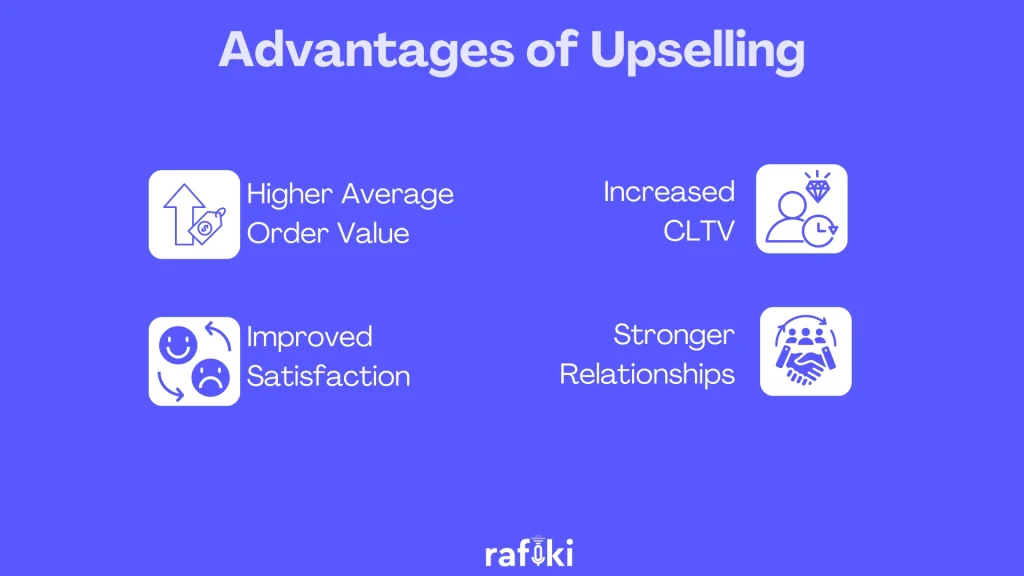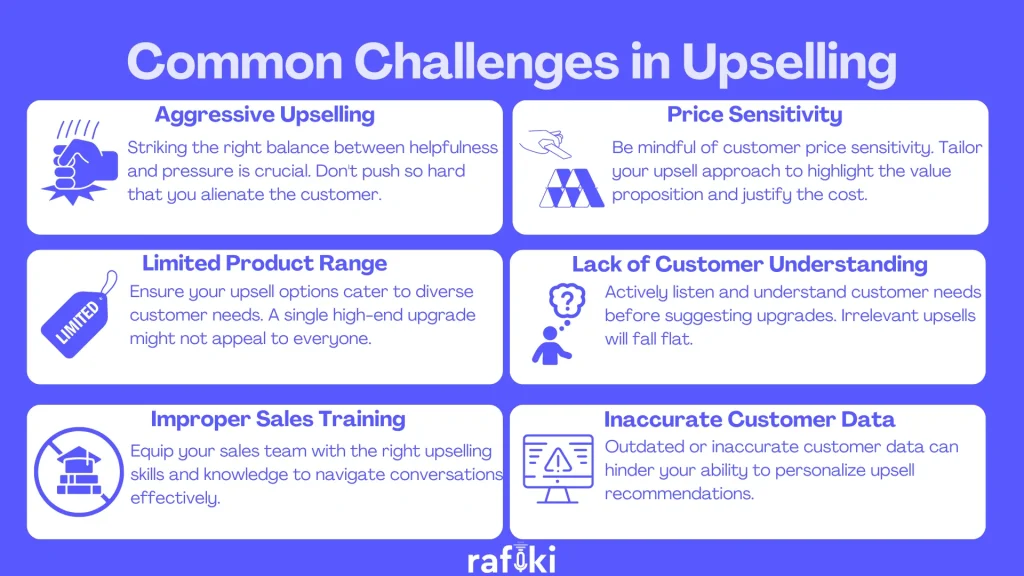Why Rafiki
Pricing


Pricing
Solutions

RevOps Leaders
Synchronize revenue generating functions

SDR Leaders
Get your team aligned and Coach your Reps 3x faster at scale

Sales Leaders
Unlock pipeline truth, drive confident forecasts

Every time a sales person meets a prospect or a customer success/account manager meets their account, there is an opportunity to make sales. But it is incredibly important that the sales or success professionals find the most optimal quantity of value to sell. This is the essence of the upsell.
If these professionals are passive, they might be leaving money on the table. If they’re aggressively selling, they might end up pushing their luck.
But how can you upsell effectively without coming across as pushy? Throughout this article, we'll explore upselling techniques that boost sales while fostering trust with your customers.
Put simply, upselling is the art of convincing a prospect or customer to upgrade their initial choice to a more feature-rich or premium version. It's about presenting a product or service that better aligns with their needs and maximizes their overall value.
Let's explore this concept with real-world examples. Imagine you're a salesperson for a B2B tech company. A customer with a basic plan for your project management solution might be upsell-ed to a premium plan that has advanced integrations with all popular softwares, enabling the customer to use your solution in their tech stack without any delays or friction.
Now, consider the B2C world. A customer browsing a furniture store might be upsell-ed from a standard mattress to a memory foam option. Here, the salesperson could emphasize the memory foam's superior comfort and potential for better sleep, directly addressing the customer's desire for a good night's rest.
Upselling, when done right, is a win-win. Customers get a product that truly serves them, and businesses boost their revenue. But remember, the key lies in understanding customer needs and presenting the upgrade as a solution, not just a pricier option.

While upselling focuses on getting customers to upgrade their initial choice, there's another sales strategy worth mentioning: cross-selling. Here's where things can get confusing! Let's break down the key difference. Upselling is like convincing a customer to get the "deluxe" version of a burger, with all the toppings. Cross-selling, on the other hand, is like suggesting fries and a drink to go with that burger.
Upselling targets the existing purchase intent. You're capitalizing on the customer's interest in a product and nudging them towards a better fit within that same category. Cross-selling, however, introduces entirely new product possibilities that complement the initial choice.
The beauty lies in potentially utilizing both techniques together. Imagine upselling a customer to a top-of-the-line laptop (upsell), and then following up with a suggestion for a high-performance mouse and carrying case (cross-sell). Understanding these distinctions empowers you to craft a strategic sales approach that maximizes customer satisfaction and increases your sales potential.

With Rafiki, your sales and customer success teams can identify upsell and cross sell opportunities early so that they’re fully prepared to craft a compelling and personalized offer. Also, such opportunities are very easy to miss if you rely only on your team to identify them. In the middle of trying to engage the prospect, learning more about them, taking notes and a dozen other priorities, such opportunities can fall through the cracks. With Rafiki, you can be rest assured that all such opportunities are identified and leveraged to maximize revenue.
Imagine you're a salesperson at an athletic shoe store. A customer walks in looking for a basic pair of running shoes. Here's your chance to utilize the pain-point pivot. Engage with the customer, inquire about their running habits, and gently probe for any pain points. Maybe they mention occasional knee discomfort. This is your golden opportunity! Pivot the conversation towards a cushioned running shoe with advanced technology designed to address knee impact. You've identified a pain point and presented the upgrade as a solution, making the upsell more relevant and valuable to the customer.
This technique involves creating a tiered pricing structure with clear distinctions between each level. Think of it like a value ladder, with basic features at the bottom and premium features at the top. For instance, an online language learning platform might offer a basic plan with limited access to lessons and exercises. The upsell comes in the form of higher tiers that unlock additional features like personalized learning plans, live tutoring sessions, and access to advanced grammar modules. By showcasing the increasing value proposition at each level, you make the upsell a natural progression for customers seeking a more comprehensive learning experience.
Ever feel overwhelmed by the constant advancements in technology? This feeling can be leveraged for upselling with the "future-proofing" approach. Let's say you're a salesperson convincing a customer about a new laptop. Instead of simply highlighting its processing power, emphasize how the upgrade will "future-proof" their purchase. Explain how the additional features will ensure the laptop remains powerful and efficient for years to come, meeting their evolving needs as technology progresses. This approach positions the upsell as a wise investment for the long term.
People are naturally influenced by the actions and opinions of others. This is where the social proof shuffle comes in. When upselling, weave testimonials and positive reviews from satisfied customers who opted for the upgraded version. Briefly showcase quotes or success stories that highlight the value proposition of the upgrade. Imagine you're selling a project management software. Share a customer testimonial about how the advanced features in the premium plan streamlined their workflow and saved them valuable time. This social proof adds credibility to the upsell and demonstrates the tangible benefits of the upgrade.
A little mystery can go a long way in piquing a customer's interest. Consider incorporating the intrigue incentive when upselling. For example, you might be showcasing a new line of skincare products. After introducing the core range, mention a limited-edition premium set with exclusive, high-performing ingredients. However, keep the details of these ingredients slightly under wraps, hinting at their powerful benefits. This creates intrigue and compels the customer to consider the upgrade to unlock the full potential of their skincare routine.
The sale might be complete, but the upsell opportunity doesn't have to end there. Consider the post-purchase power play. This technique involves strategically suggesting relevant upgrades based on the customer's initial purchase. For instance, a customer might buy a new camera. After the sale, send a follow-up email recommending compatible lenses or memory cards that enhance the camera's functionality.
Sometimes, the best way to convince someone is to let them experience the difference firsthand. This is where the "test drive" technique comes in. While not applicable to all products or services, consider offering a limited-time trial or demo of the upgraded version. This allows customers to experience the additional features and benefits for themselves.
Imagine you're selling design software. Provide a free trial of the premium plan with access to advanced editing tools and templates. By letting them test drive the upgrade, customers can see the tangible value it offers and are more likely to commit to the upsell after experiencing its capabilities firsthand.
Upselling shouldn't be a forceful tactic, but rather a way to build trust and lasting customer relationships. Ethical upselling prioritizes transparency and genuine value. Focus on truly understanding what your customers need, and then suggest upgrades that demonstrably solve their problems.
This approach builds trust and positions you as a helpful advisor, not just a salesperson. By prioritizing customer satisfaction, you create a win-win scenario where both parties benefit from the upsell.
Upselling can be a powerful tool to boost sales and enhance customer satisfaction. By mastering the art of upselling, you can encourage customers to invest in products or services that better align with their needs.
Keep in mind, the key lies in creating value, not pressure. Utilize the techniques explored here, prioritize ethical practices, and watch your upselling skills flourish. This approach not only increases your revenue but also fosters customer loyalty, creating a sustainable path to success.
Upsell The Right Way